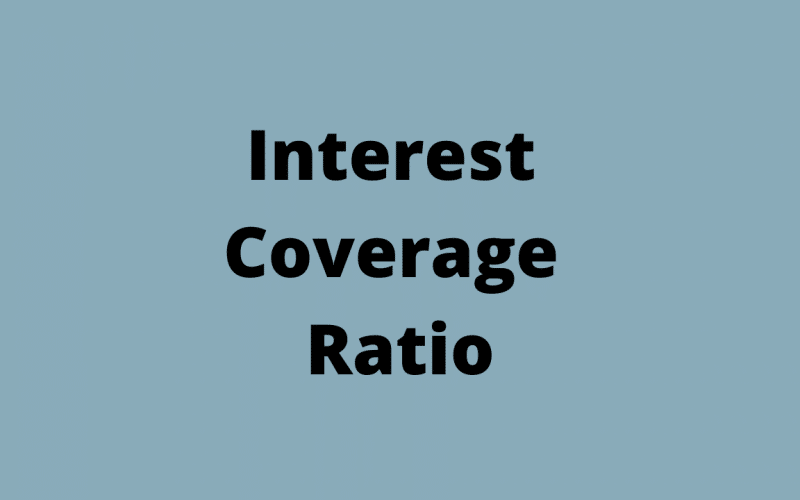In terms of risk management, the interest coverage ratio can be a useful tool for determining whether your company’s revenues are sufficient to cover the interest on its loan commitments. Start with our interest coverage ratio definition to learn everything you need to know. Because we covered all you need to know about interest coverage ratio, formula, types, analysis and so much more.
Interest Coverage Ratio
The interest coverage ratio is a financial metric that assesses a firm’s capacity to make timely interest payments on its debt. This liquidity ratio, unlike the debt service coverage ratio, has nothing to do with the ability to make principal payments on the debt. Instead, it determines the firm’s ability to pay the debt’s interest.
This calculation is used by creditors and investors to determine a company’s profitability and risk. An investor, for example, is primarily concerned with seeing his investment in the company grows in value. Profits and operational efficiencies account for a major portion of this gain. As a result, investors want to know that their company will be able to pay its obligations on time without jeopardizing its operations or earnings.
The interest coverage ratio, on the other hand, is used by creditors to determine if a company can afford the extra debt. If a corporation can’t afford to pay the interest on its debt, it will most likely be unable to pay the principal. As a result, creditors utilize this formula to determine the risk of lending.
Overview
The term “coverage” in the interest coverage ratio refers to the amount of time (usually quarters or fiscal years) that interest payments may be made with the company’s existing earnings. In basic terms, it indicates how many times the company’s earnings can be used to satisfy its debts.
The smaller the ratio, the more debt expenses burden the corporation and the fewer resources it has to invest elsewhere. A company’s capacity to meet interest expenses may be questioned if its interest coverage ratio is below 1.5 or lower.
In order to weather future, and maybe unanticipated, financial crises, businesses must have more than enough earnings to cover interest payments. The ability of a corporation to satisfy its interest obligations is a measure of its solvency, and thus a key determinant in shareholder returns.
Types of Interest Coverage Ratios
Before looking at company ratios, it’s vital to know two typical versions of the interest coverage ratio. Changes in EBIT are the source of these variances.
#1. EBITDA
When computing the interest coverage ratio, one variation utilizes profits before interest, taxes, depreciation, and amortization (EBITDA) instead of EBIT. Because this variance excludes depreciation and amortization, the numerator in EBITDA estimates is frequently higher than in EBIT calculations. Because the interest expense will be the same in both circumstances, EBITDA calculations will result in a larger interest coverage ratio than EBIT calculations.
#2. EBIAT
In another form, the ICR is calculated using earnings before interest and taxes (EBIAT) rather than EBIT. This has the effect of subtracting tax charges from the numerator, resulting in a more accurate depiction of a company’s ability to pay interest expenses. Because taxes are a significant financial factor to consider. EBIAT can be used to compute interest coverage ratios instead of EBIT to get a better view of a company’s capacity to cover its interest expenses.
Importance of the Interest Coverage Ratio
Any company’s ability to stay afloat in terms of interest payments is a significant and continuous worry. When a firm is having trouble meeting its obligations, it may have to borrow more or utilize its cash reserve. Which would be better spent on capital assets or for emergencies.
While a single ICR might disclose a lot about a company’s current financial situation. Looking at interest coverage ratios across time can frequently show a lot more about a company’s position and trajectory.
Looking at a company’s interest coverage ratios on a quarterly basis for the past five years. For example, can tell investors if the ratio is improving, dropping, or stable, and can give you a good idea of how healthy its short-term finances are.
Furthermore, the acceptability of any given level of this ratio is, to some extent, in the eye of the beholder. Some banks or potential bond buyers may be willing to accept a lower ratio in exchange for a higher interest rate on the company’s debt.
What Is a Good Interest Coverage Ratio?
If a company has a ratio that is greater than one, this suggests that they are able to pay the interest on its debts using its earnings or that they have demonstrated the ability to keep its income at a fairly steady level. Analysts and investors both prefer an interest coverage ratio of two or more, even though a level of 1.5 may be the bare minimum that can be considered acceptable. If a company has historically experienced higher levels of revenue volatility, the interest coverage ratio may not be regarded as satisfactory until it is significantly greater than three.
What Is the Importance of the Interest Coverage Ratio?
The interest coverage ratio is a type of financial metric that determines whether or not a company is able to pay off its existing debts. The general rule is that a firm is in a better position to repay its interest commitments when the ratio is larger, while a ratio that is lower indicates that the company is financially unstable. In their research, analysts typically search for ratios with a minimum of two (2) and a recommended minimum of three (3). It is not desirable to have a ratio of one (1).
What is an Interest Coverage Ratio?
The interest coverage ratio is the ratio that is used to assess how easily a company can pay the interest on its outstanding debt. This ratio is important in determining the liquidity situation of a firm by calculating how easily the company can pay the interest on its outstanding debt.
Interest coverage ratio Formula
Divide the EBIT (profits before interest and taxes) by the interest expense to arrive at the interest coverage ratio formula.
As you can see, instead of net income, the equation uses EBIT. Earnings before interest and taxes (EBIT) is essentially net income after interest and taxes have been deducted. We want an accurate picture of how much the company can afford to pay in interest. We use EBIT instead of net income in our calculations. The computation would be messed up if we utilized net income since interest expenditure would be counted twice. And tax expenses would alter depending on the amount of interest deducted. To prevent this issue, we only use earnings or revenues before paying interest and taxes.
It’s also worth noting that this technique can be used to calculate interest periods of any length. Divide the EBIT and interest expense by the number of months you want to compute to get monthly or partial-year numbers, for example.
Interest coverage ratio Example
Let’s look at an example of an ICR. Sarah’s Jam Company is a jelly and jam-jarring company that cans and sends preservatives all over the country. Sarah wants to grow her business, but she lacks the finances to buy the canning machines she requires. As a result, she visits many banks with her financial statements in order to obtain the funds she requires. Sarah earns $50,000 before interest and taxes, with interest and taxes of $15,000 and $5,000, respectively.
Sarah has a 3.33 ratio, as you can see. This means she earns 3.33 times more money than she is paying in interest. She has enough money to pay both the interest and the principle on her present obligation. This is a positive sign because it indicates that her company’s risk is low and that her operations are generating enough cash to cover her expenses.
Interest Coverage Ratio Analysis
It’s difficult to calculate a coverage ratio because it’s based on how much risk the creditor or investor is willing to bear. A bank may be more comfortable with one figure than another, depending on the required risk limitations. The fundamentals of this measurement, on the other hand, remain unchanged.
If the result is less than 1, the company isn’t profitable enough to cover its interest payments. Don’t worry about repaying the debt in principle. A corporation with a calculation of less than 1 will be unable to pay its debt interest. This type of business is extremely dangerous and would almost certainly never be for bank financing.
If the coverage equation equals 1, the corporation only produces enough money to cover its interest payments. This situation isn’t any better than the previous one, because the corporation is still unable to make the principal payments. It can only pay down the present debt’s interest when it’s due.
If the coverage ratio is more than one, the corporation is making more than enough money to satisfy its interest commitments while still having enough money left over to pay the principal. Before making any loans, most creditors need coverage of at least 1.5. In other words, banks want to ensure that a company’s current interest payments are at least 1.5 times its current interest payments.
In our previous example, Sarah’s percentage is 3.33. Her existing operations generate enough revenue to pay down her current interest rates 3.33 times over. Her business is incredibly liquid, so she should have no trouble obtaining a loan to expand.
What is a Good Interest Coverage Ratio?
The definition of an “excellent” interest coverage ratio is likely to differ by industry. The typical debt commitments of companies in the industrial and technology industries, for example, are vastly different. In general, an interest coverage ratio of at least two is the bare minimum. Investors and analysts would typically seek interest coverage ratios of at least three. which shows that a company’s revenues are predictable and stable.
A “poor” interest coverage ratio, on the other hand, is any value less than one, which indicates that your company’s earnings aren’t sufficient to service your outstanding debt. Although corporations that are having trouble servicing their debt may be able to stay afloat. A low or negative interest coverage ratio is normally a huge warning flag for investors. In many circumstances, it signifies that the company is on the verge of going bankrupt.
Should Interest Coverage Be High or Low?
In most cases, a ratio of interest paid to total debt that is larger is preferable to one that is lower. If a company has a greater ratio, it indicates that it is better able to cover its interest expenditures with the money it makes from its operations. If a company’s earnings or economic conditions continue to deteriorate, having an interest coverage ratio that is too low can indicate that the company may be in danger.
What Does it Mean if the Interest Coverage Ratio is Negative?
A ratio that is negative in terms of interest coverage has a value that is less than one. This suggests that the company’s current sales are not sufficient to repay the company’s current debt at this time. If it is less than 1.5, it indicates that the possibility of a firm being able to fulfill its interest expenses on a continuous basis is still dubious. If it is greater than 1.5, it indicates that the company is likely to be able to do so.
Where Will Interest Rates Be in 2023?
By the end of 2023, the interest rates on 30-year mortgages would fall anywhere between 5.5% and 6%, according to the most optimistic projections. Jeff Tucker, Senior Economist at Zillow, said the following: “If inflation convincingly cools down, and the Fed subsequently stops tightening monetary policy, we could see rates begin to relax back down.”
Will Interest Rates Rise in the Next Five Years?
The CBO forecasts that inflation will continue to run high in 2023 as a result of factors that cause supply to grow more slowly than demand in product and labor markets. The CBO forecasts that inflation will exceed the Fed’s long-term goal of 2 percent in 2023 before getting closer to the target in 2024. The organization projects that benchmark short-term interest rates will experience a substantial uptick in 2023.
Limitations of the Interest Coverage Ratio
The interest coverage ratio, like any other indicator, is used to assess a company’s efficiency. Has several limitations that any investor should be aware of before utilizing it.
For starters, while comparing organizations in different industries, and even within the same industry, it’s crucial to keep in mind that they vary greatly. An interest coverage ratio of two is frequently an acceptable standard for established corporations in some industries, such as utility companies.
Because of government controls, a well-established utility is more likely to have consistent production and revenue, therefore even with a low-interest coverage ratio, it may be able to meet its interest payments reliably. Manufacturing, for example, is a far more volatile industry, with a minimum acceptable interest coverage ratio of three or more.
These businesses are more likely to experience business fluctuations. For example, during the 2008 recession, automobile sales plummeted, putting the auto manufacturing industry in jeopardy. 1 Another example of an unforeseen incident that could impair interest coverage ratios is a workers’ strike. Because these businesses are more susceptible to these variations. They must rely on a higher ability to cover interest to accommodate for periods of poor revenues. Because sectors differ so greatly, a company’s ratio should be to others in the same industry ideally. Those with similar business structures and sales amounts.
What Does the Interest Coverage Ratio Tell You?
The ICR is a metric that assesses a company’s capacity to manage its debt. It’s one of several debt ratios that can be to assess a business’s financial health. The term “coverage” refers to the amount of time (usually a number of fiscal years) that interest payments can be made with the company’s existing earnings. In basic terms, it indicates how many times the company’s earnings can be to satisfy its debts.
What Does a Bad Interest Coverage Ratio Indicate?
Any value less than one is a terrible interest coverage ratio, which indicates that the company’s current earnings are insufficient to service its outstanding debt. Even with an ICR below 1.5, the prospects of a firm being able to fulfill its interest expenses on a continuous basis are still questionable, especially if the company is susceptible to seasonal or cyclical revenue troughs.
FAQs
What is a bad interest coverage ratio?
A bad interest coverage ratio is any number below 1, as this translates to the company’s current earnings being insufficient to service its outstanding debt.
What is Upsc interest coverage?
The interest coverage ratio is a debt and profitability ratio used to determine how easily a firm can pay or cover the interest on its outstanding debt. This ratio measures how many times a company can cover its current interest payment with its available earnings.
How is interest coverage ratio expressed?
The interest coverage ratio is calculated by dividing a company’s earnings before interest and taxes (EBIT) by its interest expense during a given period. The interest coverage ratio is sometimes called the times’ interest earned (TIE) ratio.
What is cash coverage ratio?
The cash coverage ratio is an accounting ratio that is used to measure the ability of a company to cover its interest expense and whether there are sufficient funds available to pay interest and turn a profit.






